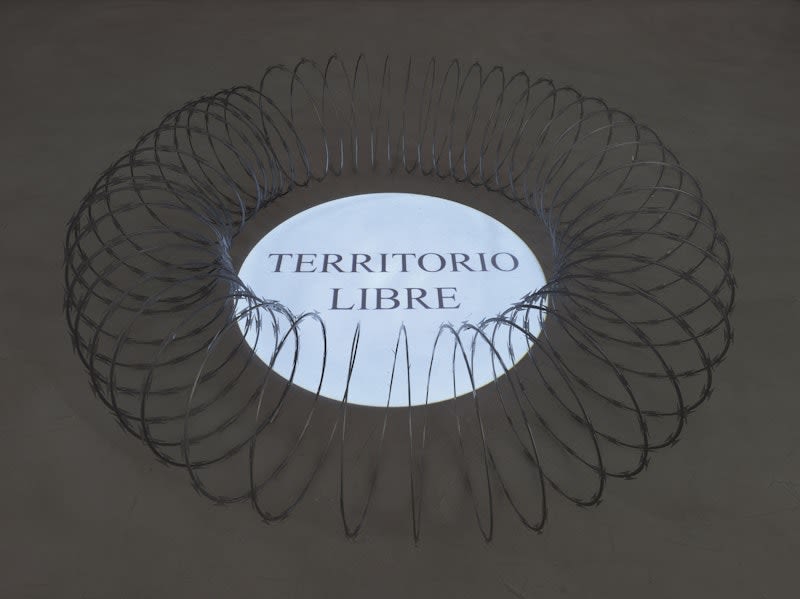Over a decade ago, I interviewed Luis Camnitzer and his ex-wife, the Argentinian artist Liliana Porter, about their early years in New York in the 1960s running the New York Graphic Workshop. At one point, Liliana Porter referred to him affectionately, I think, as the pope.
I have been thinking about that ever since. The pope of conceptualism? I suspect she may have had something more complicated in mind, and that something was on view in the elegant and minimal exhibition Towards an Aesthetic of Imbalance.
I have noticed in conceptual art in many areas in Latin America that even certain artists—Doris Salcedo, the late Graciela Sacco, Leon Ferrari, Cildo Miereles, Oscar Munoz, Luis Camnitzer, and many more—explicitly embrace the critique of art as capitalist object and vehicle of repressive values; they clothe their work in the most precise and alluring forms. Which leads me to wonder: in certain circumstances, can beauty, humor, and a sense of play be implicitly political, even when symbols of resistance are absent?
I think the conditions of art are more ironic and contradictory than that. Which brings us back to the pope, the embodiment of irony and contradiction. The pope delivers homilies, tells you what you should and shouldn’t do, and demands that you be an agent, not just an onlooker. And at the same time he commands your attention by vestment and gesture, with richness of material and authority of presentation. In other words, the supposed infallibility of the pope and his moral mandates can burden daily living, yet he remains a distracting pleasure to watch when he is all dressed up.
Luis Camnitzer’s work has always confounded me with the way it speaks so critically while assimilating seamlessly into architectural space, including the quasi-sacred but increasingly consumer-friendly temple of the museum and the white cube gallery. There often seems to be an imbalance between the political intent and the highly aesthetic presentations. At Alexander Gray Associates, the first work in the gallery is a trompe l’oeil sculpture of a pile of sheets of paper. Its title, a quote from the 19th century Venezuelan philosopher and educator Simón Rodríguez, is etched into its solid mass: Leer es resucitar ideas sepultadas en el papel. Cada palabra es un epitafio (1992). (“To read is to resuscitate the ideas entombed in paper. Every word is an epitaph.”) The literary aspect and sculptural exactness extend the work beyond something conceptually didactic. It wants your attention in a small way, like something in a dream, but beguiling. Even smaller but more sententious is Twin Towers (2002): two playing cards, a Jack and nine of diamonds, stand upright on a pedestal. It seemed to me that the effectiveness of the message—the Twin Towers representing a precarious capitalist house of cards—lasted no more than a few seconds. Again, it seemed like a dream image until its title revealed the metaphor. I wanted to hold onto the vivid impression of a delicate, impossible balance. This mysterious precision is an aspect of Camnitzer’s work I respond to, but I often feel I am pushed toward a narrow reading, from which I can all too easily move on, with my balance maintained.
The centerpiece of the exhibition is El Mirador (The Observatory) (1996)—perhaps Luis Camnitzer’s most satisfying and challenging installation—an enclosed space into which viewers looked through a horizontal eye-level cut bifurcating every wall. The objects in El Mirador, visible in their totality only if you walked all the way around it, demanded to be parsed: a house of cards, a crude metal bedstead with a sheet of glass instead of a mattress, a clothes hanger embedded in the wall adorned with a piece of lacework, a broken mirror, a tall tripod with a yellow light bulb, standing over a yellow circle in the floor. And much else.
If I read the objects correctly, as a set of symbols about observation, surveillance, incarceration, economics, and consumption, then I, the observer, was part of the problem. Also, by implication, was the gallery itself and the very notion of the “work of art.” Perhaps that was and remains Luis Camnitzer’s point: to speak to us of the contradictions of the system we live in using the signifiers of aesthetic form that this very system endorses—the ultimate bait and switch.
...
Read review at brooklynrail.org.

